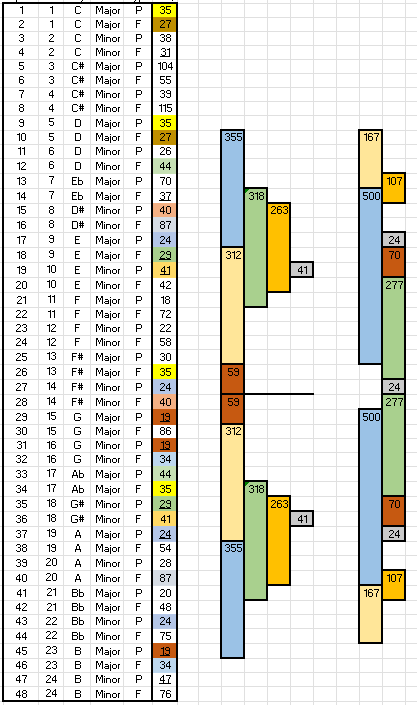I have begun running simulations for what I’m calling (at Gemini’s suggestion) “Bounded Triplets”. These are the coincidence of three different MQs sharing some combination of boundary points—meaning where the groups start/end—where Groups A and B are in ratio C; the ratio naturally is x1000, so the MQ of Group C is seen to act as a “marker” of the ratio. An example:
423/1269=.33333333333… (being exactly 1/3), the MQ of 333 from the same boundary is the [rounded and x1000] “marker”.
There are 6,222 of these triplets in the WTC1 set, which initially seems like an incredibly high amount; but for perspective, there are 1176 unique contiguous groups in a set of 48 numbers, 270,372,200 ways to combine them into groups of three, and 3,408,440 combinations which pass the “shared boundary” rule. So only %.18 of the WTC1 set’s shared boundary groups satisfy our conditions, which is not nothing, but not quite so spectacular as 6,222!
In a random set (18-115), there were on average around 5,200 (%16 fewer). The highest result (in 100 tests) was 5,729; so the odds of randomly generating 6,222 are quite close to 0. I have a fuzzy understanding of this simply being a consequence of the WTC1 set being very much non-random (as established in previous entries); repeated MQs naturally produce more of these bounded triplets. So this test is fundamentally another way of showing that the set is non-random.
My theory is that some of these triplets are intentional, and the ratios are those between simple combinations of shapes, as one would expect in any architecture. So if we test for occurrences of said ratios—1414 for the square root of two, 1732 for the square root of three, etc—we find that nearly two hundred occur in the WTC1, while only an average of around 80 occur at random. Accounting for the difference in total, the percentage occurrence is still about half—%3.13 to %1.6—and no simulated test got close the WTC1 percentage, so again, probably a chance close to 0.
Here we have to consider that there is absolutely no reason that this set of geometric ratio “markers” would occur more often than chance in the WTC1 set, even taking into account the repeated quantities (which might have an otherwise compositional excuse): the set of geometric ratios as a whole has no inherent “pattern” that could be related to MQ placement outside of intent.
Remaining skeptical, we can shuffle the actual WTC1 set, and a previous suspicion is confirmed: the average number of bounded triplets is right around 6200: their relative abundance is caused by the repeated MQs, not necessarily Bach’s ordering. Comically enough though, the number of occurrences of geometric ratios drops to %1.4.
Since the “rounding” operation for the irrational ratios is offensive to some, we can look at only the set of simple “harmonic” ratios of 1:2, 1:3, and 2:3, which can occur exactly, as in the example above. There are 31 instances across all three ratios in the WTC1, so about .5%. At random, there are .11%, and in the shuffled set, .15%. Notably, in the shuffled set, only 14% of the runs had results across all three ratios. One notes though that this subset probably is influenced by the repeated MQ patterns previously observed (for their compositeness), but, as before, that’s begging the question.
A test for simple occurrences of the geometric ratios as contiguous MQ sums (not considering bounded triplets) finds 34 instances in the WTC1 set, and from 100,000 runs:
Test 1: Random Generation (18-115)
Average Matches Found: 16.95
p-value: 0.0002
Test 2: Constrained Shuffle
Average Matches Found: 19.30
p-value: 0.0011
So there’s about a 1 in 5,000 chance that 34 constants appear at random, and a 1 in 1,000 chance that they occur even if you shuffle Bach’s chosen MQs.
It occurred to me that perhaps in this test the WTC1 order was simply more likely to produce MQs in the range of the constants, and one might argue that the constants themselves were cherry-picked, even though they are a tangibly related/externally meaningful set. So I ran a control simulation testing for hits in the range (+/- 9) of each, which Gemini called “Fuzzy Targets”.
--- Final Statistical Summary (Fuzzy Targets) ---
Observed Matches in WTC Data: 329
Test 1: Random Generation
Average Matches Found: 282.75
p-value: 0.0014
Conclusion: The count is STATISTICALLY SIGNIFICANTLY HIGHER than random chance.
Test 2: Constrained Shuffle
Average Matches Found: 319.57
p-value: 0.2039
Conclusion: The count is NOT statistically different from a constrained shuffle.
This shows that the WTC1 set itself does tend to produce MQs in the range of the geometric constants [when shuffled]; but it does not tend to produce the exact things. This would seem to indicate that there is no reason the geometric constants could be so present in the WTC1 other than conscious ordering.
-jtr




